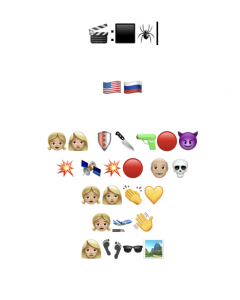Task 6: An Emoji Story

This is my favourite task to date! I really enjoyed looking through the emoji’s to see which ones worked best with my attempt to tell my aimed story.
Did you rely more on syllables, words, ideas or a combination of all of them?
In order to get the most out of the available emojis, I focused on words and ideas to display my story. I related more to the film with images than I did with words, which is why I found this task relatively easy to complete, although, that depends on whether people can understand my emoji story or not. It may be clear to me but not so much to others. However, when you think of a plot of a story, it sometimes is very clear to some viewers whereas other people don’t get the idea at all.
Kress (2005) states the following:
“As one effect of the social and the representational changes, practices of writing and reading have changed and are changing. In a multimodal text, writing may be central, or it may not; on screens writing may not feature in multimodal texts that use sound-effect and the soundtrack of a musical score, use speech, moving and still images of various kinds. Reading has to be rethought given that the common sense of what reading is was developed in the era of the unquestioned dominance of writing, in constellation with the unquestioned dominance of the medium of the book.” (Kress, 2005).
I was drawn to this quote from Kress (2005) because of how much change has happened since the era where writing really developed. As a mid-20’s adult, I recognize that I can understand emotions, ideas, and words through several different types of multimodal ‘texts’ such as; emojis, memes, and gifs. Therefore, this task seemed relatively relatable as I have grown beside these changes in writing as a millennial. My friends and I have communicated through memes and emojis without using any sort of text and can completely translate the message behind them. This is why I focused on using emojis that related to words and ideas as I communicate this way in my personal life. For example, if I am feeling sad, I use a crying face emoji, and if someone asks me what I would like for dinner, I put a sushi emoji. Kress (2005) also mentions how language is specific and concrete, meaning that when you read a word, the understanding is clear. Whereas image can leave grey areas or unclarity. However, I argue that words can leave moments of unclarity. For example, using the word “fine” can point to several different emotions. Is it really fine or are they trying to hint to the alternative? Whereas a smiley face emoji would hint to one thing, things are fine and the person is happy.
Did you start with the title? Why? Why not?
I started with the title because I have always felt that a title is detrimental to a stories plot. The title of the film I chose has a very strong meaning to it and is a symbol that is consistently brought up in the film itself. The title also consisted of two strong representative words. This is where I focused primarily on the words rather than the grand idea of the title, although I do feel my film benefited my emoji story as it is fairly self explanatory. Bolter (2001) explains how the Middle Ages used images and symbols to represent words and ideas, which for my title, was the best way to display it. For instance, the film itself could have used these exact images and would have successfully titled their movie without text.
Did you choose the work based on how easy would it be to visualize?
I chose this work as it was honestly the last film I have seen and realized that it would be fairly straightforward to choose emoji’s to represent the title and plot. Bolter (2001) explains how readers, no matter what context, are constantly visualizing what is happening whether authors are being descriptive or not. Therefore, the emojis provide the same idea. We know that these emojis don’t represent the true and exact actions of the plot, however, they place an idea, a connecting visual, in the readers brain to formulate ideas and understandings.
References:
Chapter 4. Bolter, J. D. (2001). Writing space: Computers, hypertext, and the remediation of print (2nd ed.). Mahwah, N.J: Lawrence Erlbaum Associates. doi:10.4324/9781410600110
Kress (2005), Gains and losses: New forms of texts, knowledge, and learning. Computers and Composition, Vol. 2(1), 5-22.
HI Megan, I haven’t seen the movie as yet but based on your emojis I’d have to guess Black Widow? Agreed, this is definitely my favourite task to date as well!
Black Widow?!
Black Widow – I haven’t seen it so here are my best guesses, sorry if I’m completely off.
Americans in Russia
– Two sisters are protected against an evil something (the red dot is stumping me)
– There is an explosion so they leave, but their father dies
– The sisters are okay
– They leave and find happiness in a tropical paradise
I did the same as you, focusing on words and not syllables. I wonder how far off I am. So interesting how something that looks so clear to you can mean something totally different to someone else.